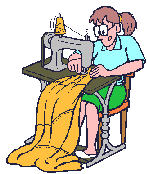Post by Deed on Jul 15, 2005 21:59:10 GMT 10
Sewing Terms
Basting Temporary stitches to keep the garment together for fitting. These are usually hand sewn lines of stitching, made with a running stitch about 5/8" or 1.5 cm in length.
Binding This is a narrow strip of fabric or tape used to cover the raw edges of a garment. It can be on the inside where it won't be seen, or on the outside to show as decoration. For many hidden uses, BIAS BINDING will be asked for.
Bias If something is cut on the true bias, it is cut at 45 degrees to the selvage. Bias cut garments were very popular in the 1930's. They drape beautifully, and cling to the figure more than straight cut garments.
Bias Binding A binding strip cut on the bias. You can buy it ready cut, or cut it from the fabric you are using to make a 'self' bias binding.
Back Stitching Back stitching is when you stitch backwards with the machine to 'lock' your stitches in place. This is generally done at the beginning and end of a seam or to reenforce a seam or pockets.
Gather To draw into small folds or puckers, as by pulling a thread through cloth.
Grain Line The warp direction of the fabric, up and down the length. If something is 'off grain' then it is not laid out with the grain line following that of the fabric.
Nap A one way direction of texture on a fabric such as velvet or corduroy. When using fabric with a nap all pieces must be cut with the nap in the same direction. This also includes one way designs on fabrics.
Notches Diamond shaped marks that stick out beyond the edge of the pattern, to help you to line up all the pattern pieces when you sew the garment. They come in pairs to be matched up.
Rolled Hem Fold raw edge under 1/4" and then 1/4" again, enclosing raw edge. Topstitch to hold hem.
Seam Allowance Distance between cutting and seam lines, usually 5/8" (1.5cm) unless otherwise stated on the pattern.
Top Stitch A row of stitching, visable on the finished product. Can be functional or decorative.
Warp The long threads that go on the loom, and follow the length of the fabric. They are usually stronger than the filler threads, which is why most garments are cut following them (i.e. on the grain).
Basting Temporary stitches to keep the garment together for fitting. These are usually hand sewn lines of stitching, made with a running stitch about 5/8" or 1.5 cm in length.
Binding This is a narrow strip of fabric or tape used to cover the raw edges of a garment. It can be on the inside where it won't be seen, or on the outside to show as decoration. For many hidden uses, BIAS BINDING will be asked for.
Bias If something is cut on the true bias, it is cut at 45 degrees to the selvage. Bias cut garments were very popular in the 1930's. They drape beautifully, and cling to the figure more than straight cut garments.
Bias Binding A binding strip cut on the bias. You can buy it ready cut, or cut it from the fabric you are using to make a 'self' bias binding.
Back Stitching Back stitching is when you stitch backwards with the machine to 'lock' your stitches in place. This is generally done at the beginning and end of a seam or to reenforce a seam or pockets.
Gather To draw into small folds or puckers, as by pulling a thread through cloth.
Grain Line The warp direction of the fabric, up and down the length. If something is 'off grain' then it is not laid out with the grain line following that of the fabric.
Nap A one way direction of texture on a fabric such as velvet or corduroy. When using fabric with a nap all pieces must be cut with the nap in the same direction. This also includes one way designs on fabrics.
Notches Diamond shaped marks that stick out beyond the edge of the pattern, to help you to line up all the pattern pieces when you sew the garment. They come in pairs to be matched up.
Rolled Hem Fold raw edge under 1/4" and then 1/4" again, enclosing raw edge. Topstitch to hold hem.
Seam Allowance Distance between cutting and seam lines, usually 5/8" (1.5cm) unless otherwise stated on the pattern.
Top Stitch A row of stitching, visable on the finished product. Can be functional or decorative.
Warp The long threads that go on the loom, and follow the length of the fabric. They are usually stronger than the filler threads, which is why most garments are cut following them (i.e. on the grain).



